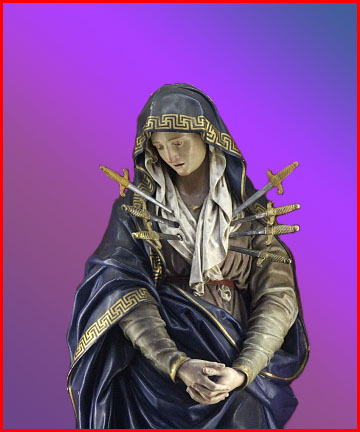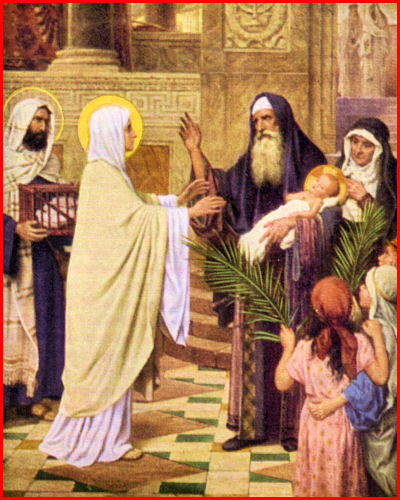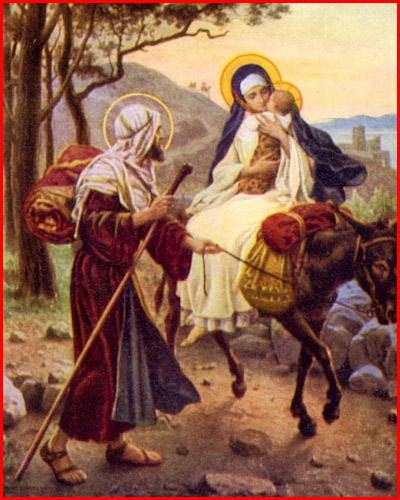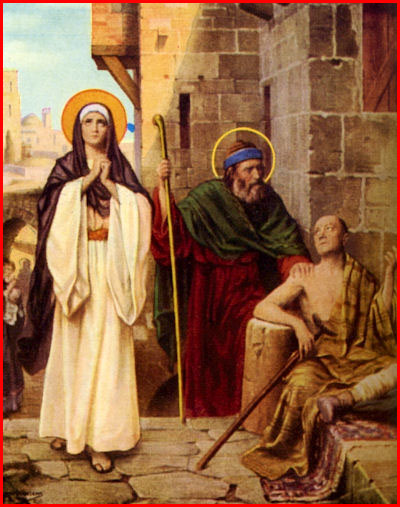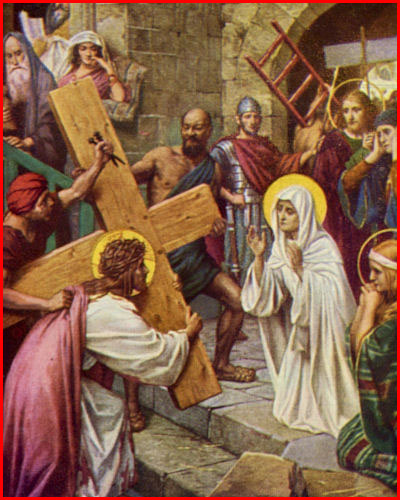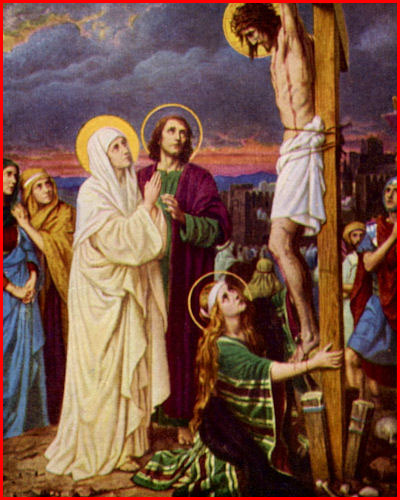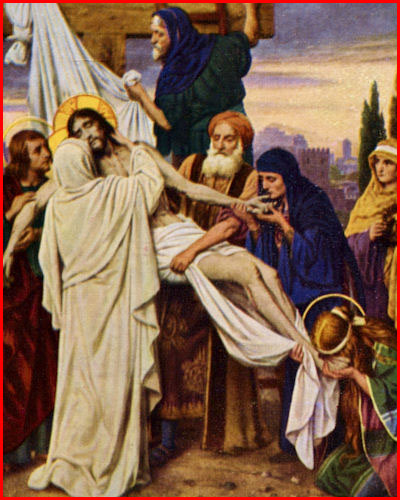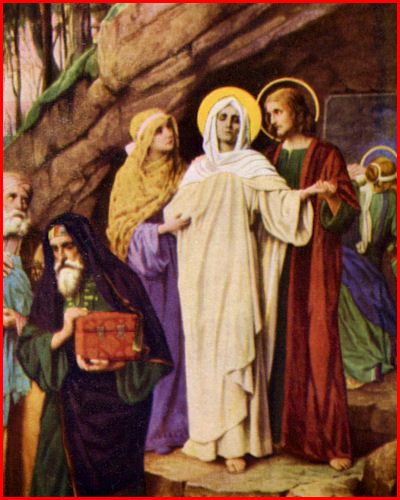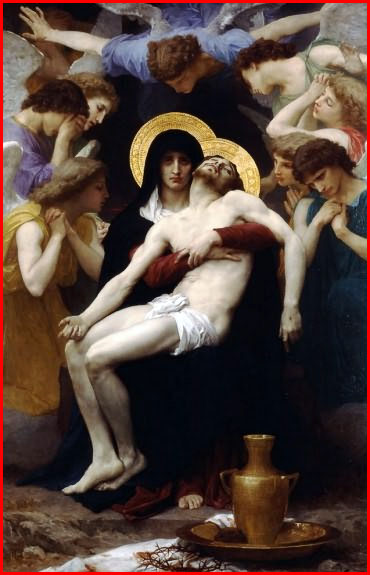| Devotion to Our Lady |
|
- Homepage
-
Daily Thoughts
- 2023 October Daily Thoughts
- Daily Thoughts Lent 2020
- Daily Thoughts for Advent 2019
- Daily Thoughts for October 2019
- Daily Thoughts for September 2019
- Daily Thoughts for August 2019
- Daily Thoughts for July
- Daily Thoughts for June
- Daily Thoughts for Easter 2019
- Daily Thoughts for Lent 2019
- Daily Thoughts for Christmas
- Daily Thoughts Easter 2022
- Sacred Heart
- Holy Ghost
-
Spiritual Life
- Holy Mass Explained
- First Friday Devotions
- First Saturday Devotions
- The Mercy of God
- Vocations
- The Path Everyone Must Walk >
- Gift of Failure
- Halloween or Hell-O-Ween?
- Ignatian Spiritual Exercises >
- Meditation is Soul-Saving
- Spiritual Communion
- Miraculous Medal
- Enrollment in Miraculous Medal
- St. Benedict Medal
- Holy Water
- Advice on Prayer
- Your Daily Mary
-
Prayers
- September Devotions
- Seven Sorrows of Our Lady
-
Novenas
>
- NV-Help of Christians
- NV-Nativity of Our Lady
- NV-Seven Sorrows
- NV- Sorrowful Heart
- NV-Pope St Pius X
- NV-La Salette
- NV-St Michael Archangel
- NV-Immaculate Heart
- NV-Assumption
- NV-Novena for Fathers
- NV-Novena for Your Mother
- NV-St Raphael Archangel
- NV-Souls in Purgatory
- NV-All Saints Day
- NV-Christ the King
- NV-Divine Motherhood
- NV-Guardian Angels
- NV-Rosary
- NV-Mirac Med
- NV- Imm Conc
- NV - Guadalupe
- NV - Nativity of Jesus
- NV-Epiphany
- NV-OL Good Success
- NV-Lourdes
- NV-St Patrick
- NV-St Joseph
- NV-Annunciation
- NV-St Louis de Montfort
- NV-OL Good Counsel
- NV-Last Supper
- NV-Passion
- NV-Pentecost
- NV-Ascension
- NV-Sacred Heart
- NV-Sacred Heart & Perpetual Help
- NV-Corpus Christi
- NV-OL of Perpetual Help
- NV-Queenship BVM
- NV-OL of Mount Carmel
- NV-St Mary Magdalen
- NV- Im Hrt
- August Devotions to IHM
- Immaculate Heart of Mary
- Litany of Dependence
- Prayers to St Mary Magdalen
- Prayers in Times of Sickness Disease & Danger
- Holy Souls in Purgatory
- Meditations on the Litany of Our Lady
- Special Feast Days
- Prayers to Mary (Mon-Sun)
- Litanies to Our Lady >
- Various & Special Needs
- Our Lady of the Rosary
- Our Lady of Mt. Carmel
- Our Lady of Perpetual Help
- Our Lady of Guadalupe
- Other titles of Our Lady
-
Rosary
- Downloads
- Consecration
- Easter Season
-
Holy Week
- Last Seven Words of Jesus >
- Characters of Passion >
- The Last Days of Christ
- Before Palm Sunday
- Palm Sunday
- Monday in Holy Week
- Tuesday in Holy Week
- Wednesday in Holy Week
- Holy Thursday (Last Supper)
- Holy Thursday (Agony & Arrest)
- Night Vigil with Christ
- Good Friday (Pilate & Herod)
- Good Friday (Way of Cross & Crucifixion)
- Saturday in Holy Week
-
Lent
- Ideas for Lent
- Daily Lenten Planner
- Daily Lenten Liturgy
- From Cold to Hot
- Lent with Aquinas
- Lent with Dom Gueranger
- Virtues for Lent
- History of Penance
- How Expensive is Sin?
- Confession of Sins
- Letter to Friends of the Cross
- Sermons for Lent
- Stations of the Cross >
- Lenten Prayers
- 7 Penitential Psalms
- Lenten Psalms SUN
- Lenten Psalms MON
- Lenten Psalms TUE
- Lenten Psalms WED
- Lenten Psalms THU
- Lenten Psalms FRI
- Lenten Psalms SAT
- Lenten Laughs
- Septuagesima
-
Christmas
- Epiphany Explained
- Suggestions for Christmas
- Food For Thought
- Christmas with Aquinas
- Christmas with Dom Gueranger
- Christmas Prayers
- Candles & Candlemas
- Christmas Sermons
- Christmas Prayers SUN
- Christmas Prayers MON
- Christmas Prayers TUE
- Christmas Prayers WED
- Christmas Prayers THU
- Christmas Prayers FRI
- Christmas Prayers SAT
- Twelve Days of Christmas >
-
Advent Journey
- Purgatory
- Christ the King
- Legion of Mary
- Scapular
-
Saints
-
Martyrs for the Faith
>
- Your Daily Martyr >
- All 365 Days of Martyrs
- Cristeros
- St Valentine & Valentine's Day
- Martyrs--Thomas Becket
- Martyrs--John the Apostle
- Holy Machabees
- Age of Martyrdom
- Carmelites of Compiegne
- Martyrs--Peter & Paul
- Martyrs--John the Baptist
- Martyrs--Andrew
- Martyrs--James the Great
- Martyrs--North American
- Martyrs--Seven Holy Sleepers
- Martyrs--Afra
- School of Martyrdom
- Martyrs--Christina
- Desert Saints >
- Saints for Sinners >
- Saints of Mary >
- History of All Saints Day
-
Martyrs for the Faith
>
- Precious Blood
- Synod 2023
-
Catechism
- Catechism Lesson 1
- Catechism Lesson 2
- Catechism Lesson 3
- Catechism Lesson 4
- Catechism Lesson 5
- Catechism Lesson 6
- Catechism Lesson 7
- Catechism Lesson 8
- Catechism Lesson 9
- Catechism Lesson 10
- Catechism Lesson 11
- Catechism Lesson 12
- Catechism Lesson 13
- Catechism Lesson 14
- Catechism Lesson 15
- Catechism Lesson 16
- Catechism Lesson 17
- Catechism Lesson 18
- Catechism Lesson 19
- Catechism Lesson 20
- Catechism Lesson 21
- Catechism Lesson 22
- Bible Study
-
Calendar
- Miracles
- Apparitions
- Shrines
- Prophecies
- Angels Homepage
- Hell
-
Church Crisis
- Conspiracy Theories
- Amazon Synod 2019 >
- Liberalism & Modernism
- Modernism--Encyclical Pascendi
- Modernism & Children
- Modernism--Documents
- The Francis Pages
- Church Enemies on Francis
- Francis Quotes
- Amoris Laetitia Critique
- Danger of Ignorance (Pius X)
- Restore all In Christ (Pius X)
- Catholic Action (Pius X)
- Another TITANIC Disaster?
- The "Errors of Russia"
- CRISIS PRAYERS
- Election Novena 2024
- The Anger Room
- War Zone
- Life of Mary
- Spiritual Gym
- Stupidity
- Coronavirus and Catholicism
- History & Facts
- Books
- Catholic Family
- Children
- Daily Quiz
-
Novena Church & Pope
- Day 01 Church-Pope Novena
- Day 02 Church-Pope Novena
- Day 03 Church-Pope Novena
- Day 04 Church-Pope Novena
- Day 05 Church-Pope Novena
- Day 06 Church-Pope Novena
- Day 07 Church-Pope Novena
- Day 08 Church-Pope Novena
- Day 09 Church-Pope Novena
- Day 10 Church-Pope Novena
- Day 11 Church-Pope Novena
- Day 12 Church-Pope Novena
- Day 13 Church-Pope Novena
- Day 14 Church-Pope Novena
- Day 15 Church-Pope Novena
- Day 16 Church-Pope Novena
- Day 17 Church-Pope Novena
- Day 18 Church-Pope Novena
- Day 19 Church-Pope Novena
- Day 20 Church-Pope Novena
- Day 21 Church-Pope Novena
- Day 22 Church-Pope Novena
- Day 23 Church-Pope Novena
- Day 24 Church-Pope Novena
- Day 25 Church-Pope Novena
- Day 26 Church-Pope Novena
- Day 27 Church-Pope Novena
- Day 28 Church-Pope Novena
- Day 29 Church-Pope Novena
- Day 30 Church-Pope Novena
- Day 31 Church-Pope Novena
- Day 32 Church-Pope Novena
- Day 33 Church-Pope Novena
- Day 34 Church-Pope Novena
- Day 35 Church-Pope Novena
- Day 36 Church-Pope Novena
- Day 37 Church-Pope Novena
- Day 38 Church-Pope Novena
- Day 39 Church-Pope Novena
- Day 40 Church-Pope Novena
- Day 41 Church-Pope Novena
- Day 42 Church-Pope Novena
- Day 43 Church-Pope Novena
- Day 44 Church-Pope Novena
- Day 45 Church-Pope Novena
- Day 46 Church-Pope Novena
- Day 47 Church-Pope Novena
- Day 48 Church-Pope Novena
- Day 49 Church-Pope Novena
- Day 50 Church-Pope Novena
- Day 51 Church-Pope Novena
- Day 52 Church-Pope Novena
- Day 53 Church-Pope Novena
- Day 54 Church-Pope Novena
- Penance Novena
- Daily WeAtheR Forecast
THE COMMEMORATION OF THE SEVEN SORROWS OF THE BLESSED VIRGIN MAY
The First Friday of Passiontide
The First Friday of Passiontide
|
The First Sorrow of Our Lady
THE PROPHECY OF SIMEON The Second Sorrow of Our Lady
THE FLIGHT INTO EGYPT The Third Sorrow of Our Lady
LOSING THE CHILD JESUS The Fourth Sorrow of Our Lady
MEETING JESUS ON THE ROAD TO CALVARY The Fifth Sorrow of Our Lady
SEEING JESUS CRUCIFIED AND DIE ON THE CROSS The Sixth Sorrow of Our Lady
RECEIVING THE DEAD BODY OF JESUS IN HER ARMS The Seventh Sorrow of Our Lady
THE BURIAL OF JESUS |
Age Old Devotion
Devotion to the Sorrows of Mary has always been a favorite devotion among Catholics. It has been sanctioned by the Church and introduced into the Missal and Breviary. In order to keep before our minds the inexpressible sufferings endured for us by the Mother of God, while she lived here on Earth with her Divine Son, the Church observes two feasts in honor of the Seven Sorrows of Mary: one on the Friday before Good Friday and the other on September 15th. The Church has enriched, with numerous indulgences, the Rosary of the Seven Sorrows, as well as a number of other devotions to the Mother of Sorrows. How touching is the beautiful hymn, Stabat Mater Dolorosa, which the Church intertwines with the public recitation of the Way of the Cross. The Church spares no pains to induce her children to venerate the sufferings of their Heavenly Mother. Seven Sorrows from Countless Sorrows Seven of her countless Sorrows have been chosen for our special veneration. These are the ones selected for the mysteries of the Rosary of the Seven Sorrows. They are: 1. The prophecy of Simeon. 2. The flight into Egypt. 3. The loss of the Child Jesus in the temple. 4. The meeting of Jesus and Mary on the Way of the Cross. 5. The Crucifixion. 6. The taking down of the Body of Jesus from the Cross. 7. The burial of Jesus. Because of these Seven Sorrows, which pierced her maternal heart, the Mother of God is often represented either as standing beneath the Cross, or as holding the lifeless Body of Jesus on her lap, her heart transfixed by seven swords, according to the prophecy of holy Simeon: “Thine own soul a sword shall pierce” (Luke 2:35). Holy Church recalls to our mind only seven of Our Lady’s sorrows, but who could form an estimate of their real number! The sufferings of the Mother of God cannot be comprehended―they are inconceivable. Although her whole life, like that of her Divine Son, was a continuous series of sufferings and tribulations, the greatest woes and trials came to her during the week of the bitter Passion and Death of Jesus, when the storm of hatred and fury burst forth with all violence against Him. During our Savior’s Passion, every glance at her suffering Son forced the sword deeper into Mary’s soul. Every sound of His voice brought special bitterness to her Heart. Every increase of her love for Him—and it increased with every moment of His Passion—augmented her sorrows. The dearer and more precious Our Lord became to her, the more keenly she felt the heart-rending woe of His cruel and ignominious Passion! In her spirit, as well as in her senses, she felt every blow that was inflicted upon her Divine Son and every insult that was offered to His sacred Person. Yet no complaint or cry escaped her lips. With heroic fortitude she suppressed her violent grief, and, wholly conformed to the Divine will, generously offered the sacrifice of her Son for the sins of the world. The Purpose of the Seven Sorrows Devotion The purpose of the Devotion of the Seven Sorrows is to promote union with the sufferings of Christ, through union with the special suffering that Our Lady endured because she was the Mother of God. By uniting ourselves with both the Passion of Christ and His holy Mother, we enter into Jesus’ Heart and honor Him greatly. He is more honored because we have so honored His Mother. The Seven Sorrows are taken from Scripture events and the devotion has a long history―although it was not officially promulgated by the Church until the early nineteenth century. Before Pope Pius VII’s formal approval, the Servite Order had permission, in 1668, to celebrate the Feast of the Seven Sorrows, because the Order was instrumental in popularizing the Seven Sorrows Devotion. In the Middle Ages, Catholic theology concentrated mostly on Christ’s Passion. However, at the side of the Man of Sorrows, the faithful always contemplated the Queen of Martyrs. Devotion to the Crucified Christ and to Our Lady of sorrows grew side by side. On Calvary there were, in a sense, two altars―one in the Body of Jesus and the other in the Immaculate Heart. Christ immolated His flesh, Mary immolated her heart, her own soul. On September 15th, the day following the ancient feast of the Holy Cross, the Church commemorates the compassion of Mary; but it is fitting during the year―especially during Lent―to honor the Sorrows of Mary. Traditionally, the first Friday of Passiontide (the Friday before Good Friday) was the Lenten commemoration of the Seven Sorrows. Mary is not mentioned in the Gospel accounts of Christ’s Transfiguration, nor in His entry into Jerusalem, but she is recorded as being present at Calvary. She understood what the Will of God was and was faithful to it, co-operating with her Son as Co-redemptrix. She had prepared the victim for sacrifice and now she offered Him on the altar of Calvary. The Gospel, John 19:25, says: “Near the Cross of Jesus stood His mother, His mother’s sister, Mary, the wife of Cleopas, and Mary Magdalene.” At Christ’s bequest, Mary was proclaimed the universal Mother of mankind from the Cross. Mary had three loves in her Immaculate Heart: God, her Son, and souls. She so loved the world that she gave her only Son. As St. Bernard said, “The sword would not have reached Jesus, if it had not pierced Mary’s heart.” Mary loved souls and on Calvary, after suffering such cruel torments she merited being the Mother of all mankind. Mary is the Apostle, because she is Co-redemptrix. Behold Mary on Calvary―she suffers and prays; she stands, as one offering sacrifice. St. Ambrose said: “I read that she stood, but I do not read that she wept.” When Mary gave us her Son, she gave us everything. Therefore it can very well be said: “Behold this heart, which has so greatly loved all people, that it has spared nothing for them.” The Seven Graces of this Devotion (As revealed to St. Bridget by the Blessed Mother) 1. I will grant peace to their families. 2. They will be enlightened about the Divine mysteries. 3. I will console them in their pains and I will accompany them in their work. 4. I will give them as much as they ask for―as long as it does not oppose the adorable will of my Divine Son, or the sanctification of their souls. 5. I will defend them in their spiritual battles with the infernal enemy and I will protect them at every instant of their lives. 6. I will visibly help them at the moment of their death, they will see the face of their Mother. 7. I have obtained this grace from my Divine Son―that those who propagate this devotion to my tears and sorrows, will be taken directly from this earthly life to eternal happiness, since all their sins will be forgiven and my Son and I will be their eternal consolation and joy. Benefits of the Devotion to the Mother of Sorrows 1. To realize the value of a soul, worth the supreme Sacrifice on Calvary. 2. To work for souls, by evangelization, duty to life's duties, and prayer for sinners. 3. To pray always, in a life of union with God; whoever has a heart similar to Jesus' and Mary's hearts, will work for the salvation of souls. When we commit sin, we bring sorrow to Our Lady, for she is, indeed our very Mother, our spiritual Mother, and she watches over us as she watched over her Child, around two thousand years ago. It pains her to watch us commit sin. It is the desire of Jesus that we should think of His Passion, to offer Him our devotion and to renew our sorrow for sin. It is also His desire―as the Church makes clear to us―that we should think of the compassion of Mary in His Passion. The Mass for the Feast of the Seven Sorrows includes the traditional hymn, the Stabat Mater, the majority of which is traditionally included in single verse format in each of the 14 Stations of the Cross. St. Bonaventure is considered the author of the Hymn. Suffering and Sorrow Are Dirty Words Sorrow is not a happy word—at least for those who seek their happiness in this life! In fact, the spirit and goal of the world is to eliminate as much sorrow as possible! Their ambition is to at least take out the pain from suffering—if they cannot altogether take out suffering itself! To avoid ‘suffering’ the heat of summer, we have air-conditioning units. To avoid ‘suffering’ the cold of winter, we have furnaces. To alleviate the ‘sufferings’ of injury, illness and disease, we have pain-killer drugs. To protect ourselves from the ‘sufferings’ of tedious, laborious, long journeys, we now cars, trains and planes that take us everywhere in a fraction of the time traveling used to take. To avoid the ‘sufferings’ of labor and toil, we now have so many power tools and machines that will do most of the work for us. The list of examples could go on forever! Nobody likes to suffer, nobody want to suffer, most people work at avoiding suffering! Many “desire to please in the flesh … only that they may not suffer the persecution of the cross of Christ” (Galatians 6:12). Yet, what does Heaven say? What did Our Lord say? What did Our Lady say? Sometimes, following the attitude of the world—all pleasure, no suffering—can lead to eternal suffering: “For what doth it profit a man, if he gain the whole world, and suffer the loss of his own soul?” (Matthew 16:26). “For unto you it is given for Christ, not only to believe in Him, but also to suffer for Him” (Philippians 1:29). “You cannot drink the chalice of the Lord, and the chalice of devils; you cannot be partakers of the table of the Lord, and of the table of devils” (1 Corinthians 10:21). Sorrow was the ‘Bread and Butter’ of Life for Jesus During His life, Jesus had tried to teach the Apostles the need for suffering. Jesus insisted that He, Himself, was born to suffer and willingly chose to suffer, rather than avoid suffering: “It is written of the Son of man, that He must suffer many things and be despised” (Mark 9:11). “The Son of man must suffer many things” (Luke 9:22). This scandalized many, even St. Peter, who vehemently argued that these things would not happen to Jesus, that he—Peter—would not let them happen. The following passage relates this incident: “From that time Jesus began to show to His disciples, that He must go to Jerusalem, and suffer many things from the ancients and scribes and chief priests, and be put to death, and the third day rise again. And Peter taking Him, began to rebuke Him, saying: ‘Lord, be it far from Thee, this shall not be unto Thee.’ Jesus, turning, said to Peter: ‘Go behind Me, Satan! Thou art a scandal unto Me! Because thou savourest not the things that are of God, but the things that are of men!’ Then Jesus said to His disciples: ‘If any man will come after Me, let him deny himself, and take up his cross, and follow Me. For he that will save his life, shall lose it: and he that shall lose his life for My sake, shall find it” (Matthew 16:21-25). “And whosoever doth not carry his cross and come after Me, cannot be My disciple” (Luke 14:27). Lessons Fall on Deaf Ears At the Last Supper, Jesus tried to prepare them for His and their own sufferings, saying: “Amen, amen I say to you, that you shall lament and weep, but the world shall rejoice; and you shall be made sorrowful, but your sorrow shall be turned into joy. A woman, when she is in labor, hath sorrow, because her hour is come; but when she hath brought forth the child, she remembereth no more the anguish, for joy that a man is born into the world. So also you now indeed have sorrow; but I will see you again, and your heart shall rejoice; and your joy no man shall take from you!” (John 16:20-22). Sadly, despite all the lessons that Jesus tried to teach His Apostles about suffering, they just didn’t seem to catch-on to the need and necessity of suffering. When the “chips were down” and the Passion arrived, Jesus stayed around to suffer, while the Apostles fled! They may have learned the lesson in theory, but, in practice, they failed miserably! Jesus even came close to avoiding the ultimate crowning suffering to His long life of suffering—as He begged His Father, during His Agony in the Garden, to take away this ultimate chalice of suffering from Him. Nevertheless, He acquiesced to the will of His Father: “Jesus began to grow sorrowful and to be sad. And going a little further, He fell upon His face, praying and saying: ‘My Father, if it be possible, let this chalice pass from Me! Nevertheless, not as I will, but as Thou wilt!’ Again the second time, He went and prayed, saying: ‘My Father, if this chalice may not pass away, but I must drink it, Thy will be done!’” (Matthew 26:37-42). Driving the Lesson Home After His Resurrection, Jesus encountered sadness and despondency among His disciples at the sufferings He had undergone throughout His Passion and Death. Nobody had understood and grasped the need for what had happened. Jesus explained to the Apostles that the suffering was necessary: “Thus it is written, and thus it behooved Christ to suffer, and to rise again from the dead, the third day!” (Luke 24:46); and, to the two disconsolate and sad disciples, walking on the road to Emmaus, He said: “God before had showed, by the mouth of all the prophets, that His Christ should suffer!” (Acts 3:18). After Christ’s departure at the Ascension and the descent of the Holy Ghost at Pentecost, the Apostles finally understood and took those lessons to heart; and, after being arrested and punished by the Jewish Sanhedrin, they “went from the presence of the council, rejoicing that they were accounted worthy to suffer reproach for the Name of Jesus” (Acts 5:41). All of them were given a life of suffering by Divine Providence, which they embraced to the point of martyrdom—the pinnacle of both love and suffering:”Greater love than this no man hath, that a man lay down his life for his friends” (John 15:13). St. Paul—Man of Suffering Later, when Our Lord converted St. Paul, He said of Paul: “I will show him how great things he must suffer for My Name’s sake” (Acts 9:16). Yet, as St. Paul so wisely says later: “God forbid that I should glory, save in the Cross of our Lord Jesus Christ; by whom the world is crucified to me, and I to the world” (Galatians 6:14). “The sufferings of Christ abound in us” (2 Corinthians 1:5). “We foretold you that we should suffer tribulations” (1 Thessalonians 3:4). “In all things we suffer tribulation, but are not distressed; we are straitened, but are not destitute” (2 Corinthians 4:8-9); “we are reviled, and we bless; we are persecuted, and we suffer it” (1 Corinthians 4:12). “For I reckon that the sufferings of this time are not worthy to be compared with the glory to come, that shall be revealed in us” (Romans 8:18). “We suffer with Him, that we may be also glorified with Him” (Romans 8:17). “If we suffer, we shall also reign with Him” (2 Timothy 2:12). What is our Approach and Attitude to Suffering? Sometimes, perhaps, we wholeheartedly agree with Psalmist, when he says: “Thou hast shown Thy people hard things; Thou hast made us drink wine of sorrow!” (Psalms 59:5). Likewise, perhaps, we have all been in a situation when we could say: “The sorrows of death have encompassed me and the perils of Hell have found me! I met with trouble and sorrow!” (Psalm 114:3). Our Lady told St. Bernadette that she would not make her happy in this world, but in the next! This is an echo of Our Lord’s words to His Apostles at the Last Supper, when He told them that they would be sorrowful and that world would rejoice, but that their sorrow would be turned into joy—but only in Heaven! Even though Our Lord had said that it is impossible to serve two masters—God and the world of mammon (pleasure and treasures)—many think that they can prove Him wrong. The want joy and pleasure here below, and then joy and pleasure in the after-life! St. Paul warns us of these kinds of people: “For many walk … that they are enemies of the Cross of Christ” (Philippians 3:18). They want no part in the sufferings of Christ. This so well stated by the Imitation of Christ: “Jesus has always many who love His heavenly Kingdom, but few who bear His Cross. He has many who desire consolation, but few who care for trial. He finds many to share His table, but few to take part in His fasting. All desire to be happy with Him; few wish to suffer anything for Him. Many follow Him to the breaking of bread, but few to the drinking of the chalice of His Passion. Many revere His miracles; few approach the shame of the Cross” (Book 2; Chapter 11). Let us remember the words of that great Doctor of the Church, St. Augustine, who said that the same sufferings lead some souls to Heaven and lead other souls to Hell. Yes! The very same sufferings have two very different outcomes! It all depends upon whether we accept the sufferings in a Christian manner (and endure them meritoriously), or whether we despise the sufferings like pagans or worldlings, and in anger we try to get rid of them. Sufferings We Deserve Sometimes we know that we deserve suffering—as in the case of punishment for our sins: “For we suffer thus for our sins!” (2 Machabees 7:32). “O that my sins, whereby I have deserved wrath, and the calamity that I suffer, were weighed in a balance! … He shall be punished for all that he did, and yet shall not be consumed―according to the multitude of his works [sins], so also shall he suffer!” (Job 6:2; 20:18). Unjust Suffering At other times, we also suffer wrongs or injustice, we suffer for something we have not done: “All that will live godly in Christ Jesus, shall suffer persecution” (2 Timothy 3:12). “The Lord doth mercies, and judgment for all that suffer wrong” (Psalm 102:6). “Blessed are they that suffer persecution for the sake of justice―for theirs is the Kingdom of Heaven” (Matthew 5:10). “Wherefore let them also, that suffer according to the will of God, commend their souls in good deeds to the faithful Creator” (1 Peter 4:19). “And God is faithful, Who will not suffer you to be tempted above that which you are able” (1 Corinthians 10:13). “I suffer grevious pains in body―but in soul am well content to suffer these things because I fear thee” (2 Machabees 6:30). “For this is thankworthy, if for conscience towards God, a man endure sorrows, suffering wrongfully” (1 Peter 2:19). “My children, suffer patiently the wrath that is come upon you―for thy enemy hath persecuted thee, but thou shalt quickly see his destruction” (Baruch 4:25). “His sorrow shall be turned on his own head and his iniquity shall come down upon his crown” (Psalms 7:17). “Fear none of those things which thou shalt suffer! ... Be thou faithful until death: and I will give thee the crown of life!” (Apocalypse 2:10). “Jesus said: ‘Can you drink the chalice that I shall drink?’ They say to Him: ‘We can!’ He said to them: ‘My chalice, indeed, you shall drink!’” (Matthew 20:22-23). St. Mark also recounts the same incident with some more detail: “Jesus said to them: ‘Can you drink of the chalice that I drink of, or be baptized with the baptism wherewith I am baptized?’ But they said to Him: ‘We can!’ And Jesus said to them: ‘You shall indeed drink of the chalice that I drink of, and with the baptism wherewith I am baptized, you shall be baptized!’” (Mark 10:38-39). Here we can see the chalice of suffering and the baptism of blood, which is the ultimate suffering—death. Let us reply with Psalmist: “I will take the chalice of salvation; and I will call upon the Name of the Lord” (Psalms 115:13). Remembering the words of Scripture: “Take all that shall be brought upon thee and in thy sorrow endure, and in thy humiliation keep patience” (Ecclesiasticus 2:4). “For I reckon that the sufferings of this time are not worthy to be compared with the glory to come, that shall be revealed in us” (Romans 8:18). “If we suffer, we shall also reign with Him!” (2 Timothy 2:12). Our Lady and Suffering This is exactly what Our Lady did during her life on Earth. She revealed to the Venerable Mary of Agreda, that there was not one moment throughout her life—and in that of her Divine Son’s life—that they did not suffer in one way or another. Suffering was the ‘daily bread’ that their Heavenly Father gave them day after day. This is why Our Lord wants Our Lady to be honored for her sufferings today—as revealed in the modern-day Marian apparitions and those of Our Lord to Berthe Petit, the Franciscan Tertiary: “Teach souls to love the Heart of My Mother pierced by the very sorrows which pierced Mine …. Make My Mother’s Heart, transfixed by sorrows that rent Mine, to be loved” (Our Lord, December 25th, 1909). “The Heart of My Mother has the right to be called ‘Sorrowful’—and I wish this title placed before that of Immaculate, because she has won it herself … She has earned it by her identification with My sorrows, by her sufferings: by her sacrifices and her immolation on Calvary endured in perfect correspondence with My grace for the salvation of mankind.” (Our Lord, September 8th, 1911). Our Lady of Fatima manifested her Immaculate Heart as Sorrowful, less than six years later, at the second apparition of Our Lady at Fatima, on June 13th, 1917. Lucia relates: “In front of the palm of Our Lady’s right hand, there was a heart encircled with thorns, which pierced it. We understood that it was the Immaculate Heart of Mary―outraged by the sins of humanity―and that she wanted reparation.” At the sixth apparition of Our Lady of at Fatima, on October 13th, 1917, Lucia says: “l saw Our Lord, and Our Lady who appeared to me to be Our Lady of Dolors [Sorrows].” In the vision concerning the five first Saturdays, which took place on December 10th, 1925, the Blessed Virgin Mary appeared to Lucia with the Child Jesus by her side. She held a heart surrounded with sharp thorns. At the same time the Child Jesus said: “Have pity on the Heart of your most Holy Mother! It is covered with the thorns, with which ungrateful men pierce it at every moment, and there is no one to remove them with an act of reparation!” Then Our Lady said to Lucia: “My daughter, look at My Heart, surrounded with the thorns, with which ungrateful men pierce it at every moment by their blasphemies and ingratitude! You, at least, try to console me!” In Lucia’s last vision, which took place in June of 1929, Lucia states that: “Our Lady was beneath the right arm of the Cross. It was Our Lady of Fatima with Her Immaculate Heart ... with a crown of thorns and flames.” Our sorrows and sufferings are but pale reflections, or echoes, of the sorrows and sufferings of Our Holy Mother! They help us resemble her; they make us recognizable as her spiritual children. Let us thank God for our crosses, sorrows and sufferings, and not look upon them as curses, but as blessings! “Blessed are they that suffer … for theirs is the Kingdom of Heaven” (Matthew 5:10). |
Web Hosting by Just Host


